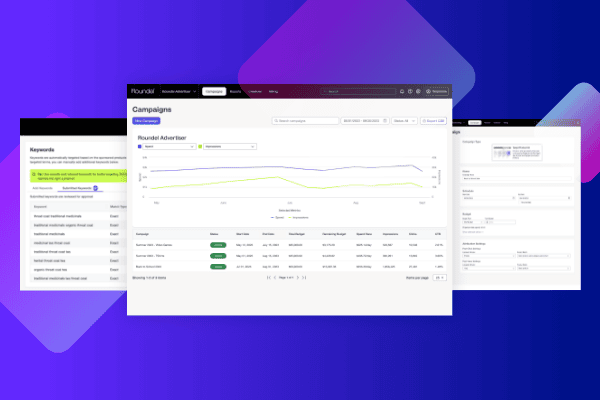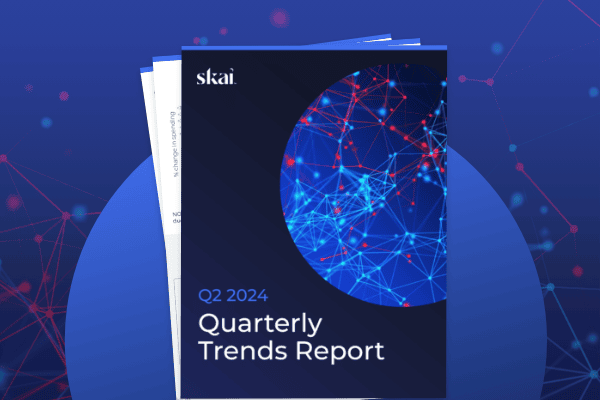Summary
Today’s marketers should adopt an omnichannel approach, integrating the advantages of both walled gardens and the open web. This strategy benefits advertisers, publishers, and audiences by leveraging the strengths of each for seamless customer experiences, enhanced personalization, and optimized advertising spending. The evolving commerce media landscape exemplifies this, requiring new technological solutions for unified media management and audience expansion across diverse platforms.
Since the early days of digital advertising, there has been much discussion about the advantages and drawbacks of walled gardens versus the open web. This adversarial paradigm has been driven chiefly by publishers and technology vendors vying for ad budgets entrenched in either arena, publicly casting themselves as guardians of privacy and user experience on the one hand or as defenders of democracy and consumer choice on the other.
However, this David-vs.-Goliath framing is a false dichotomy that is not only irrelevant to today’s consumers but, even worse, detrimental to any brand trying to connect with and engage them efficiently and effectively.
Today’s marketers need — and are increasingly looking for — an omnichannel approach that leverages the respective advantages of the walled garden and the open web in a smart, integrated strategy that mutually benefits advertisers, publishers, and audiences. An approach that is already bearing fruit in the burgeoning world of commerce media.
Walled gardens: where satisfied customers bloom
The closed ecosystems of walled gardens attract the lion’s share of digital ad budgets – for example, in 2024, walled gardens are projected to account for 71.5% of US programmatic digital display ad spending, according to eMarketer. And at the same time, retail media networks (also classified as walled gardens) such as Amazon and Walmart are growing faster than almost any other form of ad spend, garnering 21.8% of all digital ad budgets this year. To put it more starkly, advertisers will spend about $2.50 with walled gardens for every $1 on the open web in 2024.
One reason for advertisers’ lopsided adoption of walled gardens is their massive appeal to audiences. A survey of 1,000 consumers by Skai found that the top four individual digital properties where they spent their time online were all walled gardens – spanning social media, search engines, video sites, and ecommerce.

Even more importantly, consumers are disproportionately receptive to advertising in walled gardens. The same survey found that 65% of people consider advertisements in walled gardens more helpful than those on the open web, 77% turn to walled gardens first to research products, and 49% have made purchases directly after clicking on ads served to them in walled gardens.
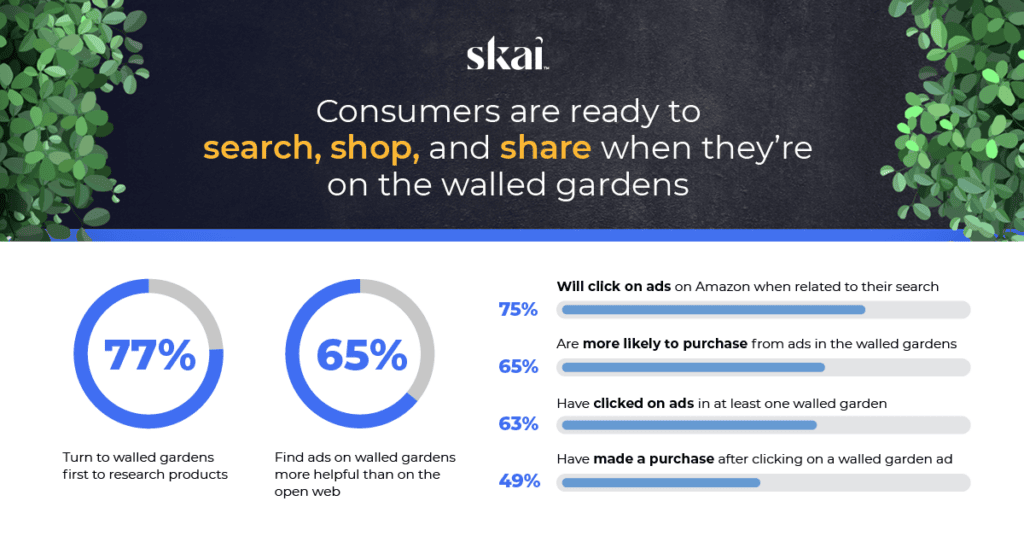
This influx of ready, willing, and engaged consumers has allowed walled gardens to cultivate rich first-party data that in turn provides advertisers with a deep understanding of logged-in user behavior within these ecosystems. And the ability to confidently target specific audience segments for more efficient ad spending and higher conversion rates will be only more invaluable as third-party cookies continue to be phased out.
Open web: reach and transparency
But although walled-garden powerhouses like Google, Meta, and Amazon have enormous credibility and resonance with audiences, digital consumers still spend 61% of their cumulative time on the open internet, according to research firm GlobalWebIndex. Consequently, the open web’s share of US programmatic digital display advertising has increased year-over-year since 2021 and is expected to continue growing through 2025, if not beyond, whittling away at the walled gardens.
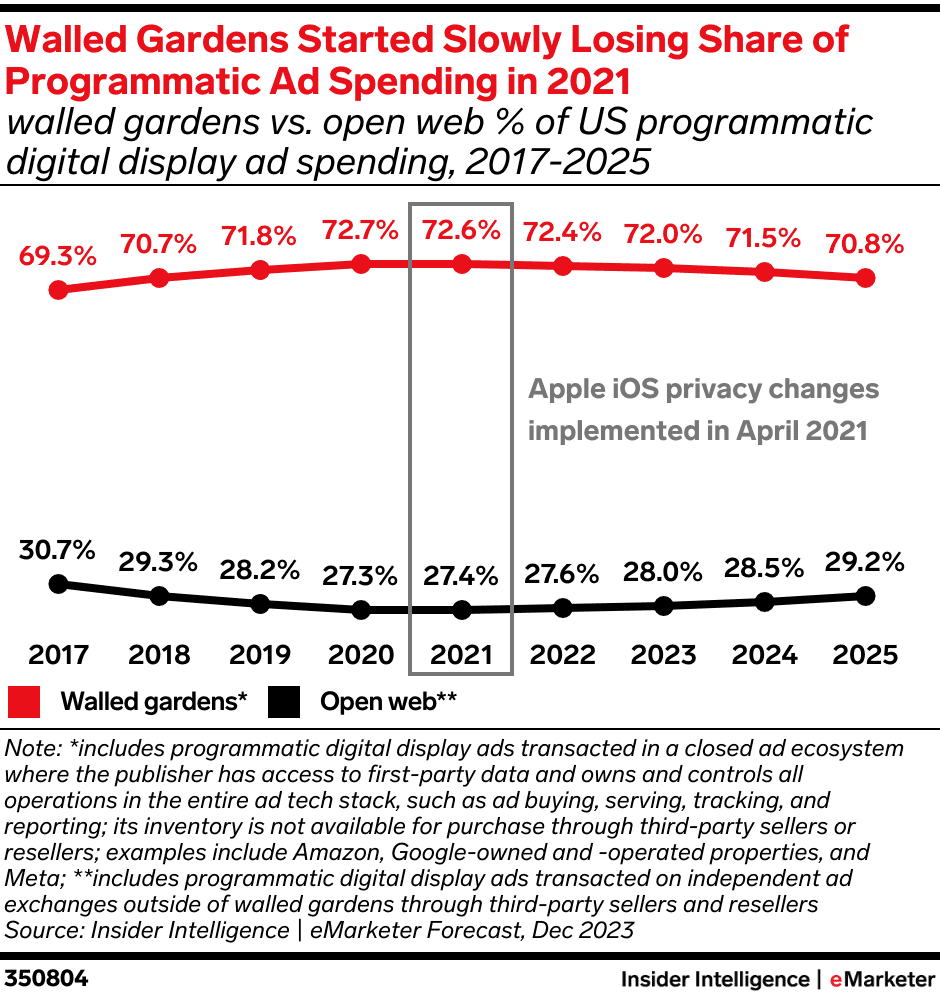
The open web also offers more transparency in ad placements and performance measures than walled gardens, giving advertisers more freedom and control in maximizing their campaigns – not to mention competitive pricing. Companies that want to avoid the limitations of closed ecosystems and value data-driven decisions depend on this openness.
The best of all worlds: commerce media’s omnichannel approach
Put aside the antagonistic attitudes and self-serving stances expressed during earnings calls, in the press, and on industry panels, and it’s clear that both walled gardens and the open web offer distinct strengths, behooving advertisers to explore an omnichannel strategy to the benefit of their brands, clients, and consumers.
After all, the pie is only getting larger for everyone involved as total media ad spending increases in 2024 at one of its fastest rates ever, according to eMarketer. It is projected to grow by 10% for a total of $992 billion, with 70% of that going to digital advertising, which will enjoy a spending increase of more than 13%, well above its growth rates of the past two years.
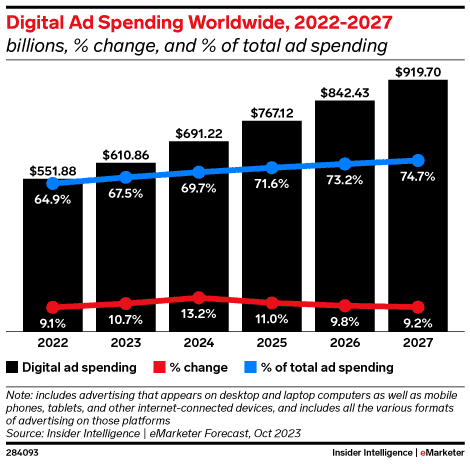
By leveraging walled gardens and the open web together, companies can optimize their reach and ensure no customer touchpoint is missed, leading to more effective marketing campaigns.
An omnichannel strategy offers several significant advantages:
Seamless customer experience
Whether within walled gardens or on the open web, an omnichannel approach ensures a consistent and seamless customer experience across all platforms. This is vital for building and maintaining consumer trust and loyalty.
Enhanced personalization
Combining the rich, structured data from walled gardens with diverse insights from the open web enables advertisers to deliver highly personalized and relevant advertising experiences. This tailored approach can significantly boost engagement and conversion rates.
Maximized reach and engagement
By tapping into the extensive reach of the open web and the precise targeting capabilities of walled gardens, businesses can maximize their audience engagement and ensure they connect with consumers where the latter are most active and comfortable.
Flexibility and adaptability
An omnichannel strategy allows businesses to remain agile and responsive, utilizing the best tools and technologies from walled gardens and the open web. This adaptability is crucial for staying ahead of industry trends and incorporating innovations quickly.
Optimized advertising spend
With an omnichannel approach, advertisers can allocate their budgets more efficiently, reducing wasted spend and increasing the return on investment. By leveraging the strengths of both ecosystems, businesses can achieve more impactful campaigns.
This omnichannel mindset has already been validated by the growing success of commerce media – not to be confused with retail media. As my colleague Nich Weinheimer explained in Total Retail, while both rely on the consumer signals provided by commerce data, “retail media operates under the control of retailers and is primarily designed to convert shoppers where transactions occur — whether online, in-store, or even across their owned, non-ecommerce domains.” In other words: walled gardens.
Commerce media, by contrast, casts a wider net, “incorporating any advertising effort that leverages commerce data to influence consumer behavior across various platforms, not limited to retail-owned properties.” This can include social commerce, connected TV (CTV), paid search, in-app marketing, and more – everything from the established walled gardens to the hundreds of retail media networks to the thousands of publishers on the open web. Omnichannel marketing for omnivorous consumers and the brands, agencies, and advertisers eager to connect with them wherever they may be found in today’s dynamic, complex digital landscape.
New technological solutions are needed to empower omnichannel marketers in commerce media and beyond
Despite the advances already made in the commerce media space, it will take more than an embrace of omnichannel planning to overcome the fragmented nature of today’s multi-platform, multi-channel, multi-publisher digital advertising playing field. New tools and technologies are desperately needed because, to be blunt, the current ones are simply not enough.
For example, a demand-side platform (DSP) was once considered the only solution a brand or agency needed to manage audiences, channels, and publishers in one user-friendly solution. But, as global market research company Forrester noted in its Omnichannel Demand-Side Platforms Landscape:
…the proliferation of walled gardens like Google and Amazon means marketers must use multiple platforms, each with unique inventory and intent signals, to reach audiences across the spectrum of addressability.
Today, many marketers have a primary, secondary, and even tertiary DSPs, which turns marketers into systems integrators. Marketers now seek more modular DSPs that they can stitch together to get a 360-degree view of their programmatic advertising’s efficacy.

And now, even that daisy chain of DSPs is falling short, as market intelligence firm IDC noted in its Worldwide Demand-Side Platforms Vendor Assessment: “DSP vendors and advertisers continue to awkwardly navigate decisions around ‘walled gardens’ versus the ‘open web.’ In principle, DSPs act as a bridge for marketers to navigate both spaces. In reality, however, brands are inevitably left to manage multiple spheres (e.g., walled gardens and open web), and often multiple tools within each sphere (for example, Google ads + Facebook ads + web DSP + mobile DSP specialist). This multi-DSP reality, while frustrating, seems to be the norm for digital advertisers seeking to capture the broadest audience set.”
This reality for marketers is expensive to maintain, resource-intensive, and more multichannel than truly omnichannel. And even worse, it’s outdated: DSPs were once synonymous with programmatic digital advertising on the open web. Now it’s just as likely to refer to delivering display ads within a single walled garden.
But here’s the positive outlook – this doesn’t have to be the norm.
One platform to unify them all
Technology that allows different and disparate parts of the advertising ecosystem to work together seamlessly is tantalizingly within reach. We know what it must entail. It must take the shape of one singular unified platform that bridges the open and closed web, enabling brands to meet consumers in the moment while providing capabilities for effective omnichannel marketing and for integrating diverse data sources and ad formats to create cohesive campaigns.
This solution absolutely must provide marketers with:
Unified media management that includes campaign management; AI-powered optimization; cross-channel reporting; and forecasting and planning based on performance data from both walled gardens and the open web.
Audience expansion capabilities that allow advertisers to understand which audiences are performing (and how) across publishers and across walled gardens and the open web, with effective targeting and accurate measurement that is still fully privacy compliant.
Advanced retail media management that provides retailers with a customized enterprise-level system that allows them to easily connect disparate technologies, data sets, and workflows to more effectively operationalize their retail media networks both onsite and offsite, setting them up to take advantage of the omnichannel evolution of commerce media.
The winning equation: walled gardens + open web
The divide between walled gardens and the open web is less contentious than it seems. An integrated approach that leverages the strengths of both can be highly effective. By adopting an omnichannel strategy, advertisers can create a secure ecosystem with precise targeting from walled gardens and the broad reach and transparency of the open web.
The result will be an ecosystem that is secure, innovative and user-friendly. After all, the next era of digital engagement is not about choosing sides but about harmonizing diverse platforms to deliver the best possible experiences for advertisers and publishers, buyers and suppliers, brands and consumers.
A garden where commerce, content, and commercialization flourish side by side, unencumbered by the walls of doubt.
The future is wide open.






